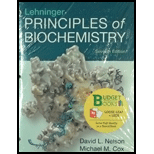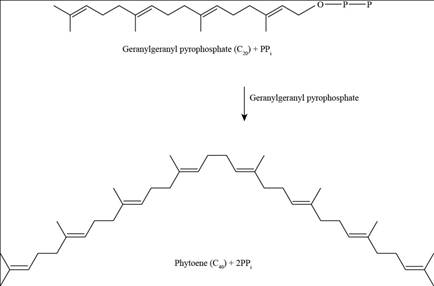
Concept explainers
(a)
To draw: The circle on isoprene unit in the astaxanthin molecule.
Introduction:
Isoprenoids are the natural occurring precursor of cholesterol and contain a huge variety. Isoprenoids are synthesized by the mevalonate pathway and are commercially and medically important. Their synthetic production is a low yielding expensive process.
Isoprenoids are the precursors of astaxanthin, which is a type of carotenoid. It appears red orange in color. It serves as a strong antioxidant that can be absorbed by humans.
(a)
Explanation of Solution
Pictorial representation: Fig.1 shows isoprene unit in astaxanthin molecule.

Fig.1: Isoprene unit in astaxanthin molecule.
Explanation:
Astaxanthin molecule is made up of eight isoprene molecules. It is a type of carotenoid which occurs in salmon, algae, shrimp, and lobster, and appears orange-red in color.
(b)
To determine: Whether two molecules of geranylgeranyl pyrophosphate are joined head to head or head to tail.
Introduction:
Phyotene is an intermediate formed during the synthesis of astaxanthin and other carotenoid molecule. Its function is to maintain the growth and development of plastids.
(b)
Explanation of Solution
Pictorial representation: Fig.2 shows the Phyotene.

Fig.2: Phyotene.
Explanation:
Phyotene molecules are formed by “head-to-head joining” of two geranylgeranyl pyrophosphate molecules, as phyotene contain dimethyl group at the tail position. The joining of two geranylgeranyl pyrophosphate molecules releases diphosphate during joining without releasing a free -OH group.
(c)
To determine: The chemical transformation during the production in step five of astaxanthin synthesis.
Introduction:
Phyotene is an intermediate formed during the synthesis of astaxanthin and other carotenoid molecule. Its function is to maintain the growth and development of plastids.
(c)
Explanation of Solution
Explanation:
In chemical transformation during fifth step, phyotene is converted into lycopene. The enzyme dehydrogenase is responsible for catalyzing the transformation reaction and it converts four single bonds into double bond.
(d)
To determine: The requirement of net oxidation for cyclization during cholesterol synthesis.
Introduction:
Cholesterol consists of four ring structure which is fused together. It contains two methyl groups which lie above the plain containing four rings. Cholesterol is a component of plasma protein and plasma membrane, and present in abundance in nerve tissues
(d)
Explanation of Solution
Explanation:
There is no requirement of net oxidation for cyclization during cholesterol synthesis as during this process, two single bonds are replaced by double bond, hence there is no oxidation or reduction.
(e)
To determine: The step in the pathway which is catalyzed by the enzyme encoded by gps gene
Introduction:
Two geranylgeranyl pyrophosphate molecules are joined together and results in the formation of phyotene. The reaction releases diphosphate during joining without releasing a free –OH group
(e)
Explanation of Solution
Explanation:
Gene gps encodes the enzyme which regulates the steps one to three in the pathway. The pathway represents the conversion of
(f)
To determine: The expression level of the enzyme which is capable of catalyzing step 3 of the astaxanthin synthesis pathway.
Introduction:
Isoprenoids are the precursors of astaxanthin, which is a type of carotenoid, and appear red orange in color. It serves as a strong antioxidant that can be absorbed by humans.
(f)
Explanation of Solution
Explanation:
The comparison of strain1 through strain 4 does not express astaxanthin, whereas strain 5 through strain 8 shows over expression of gene crtE and leads to overproduction astaxanthin.
Third step of astaxanthin involves the conversion of farnesyl pyrophosphate into geranylgeranyl pyrophosphate, in wild type E. coli strain.
(g)
To determine: The enzyme which is rate limiting in the astaxanthin synthesis pathway.
Introduction:
In the astaxanthin synthesis pathway in E. coli, enzymes are encoded by crtBIZYW, crtE, ispA and idi genes, which catalyze the pathway and yield astaxanthin. The idi encodes for IPP isomerase.
(g)
Explanation of Solution
Explanation:
The ispA gene catalyzes step one and two of the pathway in strain 5 and 6 and results in a little increase in the production of astaxanthin. idi gene catalyzes the process in the strain 7 and strain 8 and shows increase in the production of astaxanthin. Hence, the enzyme IPP isomerase catalyzes the rate limiting step of the pathway when the gene crtE is overexpressed.
(h)
To determine: Whether a strain overexpressing crtBIZYW, gps and crtE genes will produce low (+), medium (++), or high (+++) levels of astaxanthin, as measured by its orange color
Introduction:
In the astaxanthin synthesis pathway in E. coli, enzymes are encoded by crtBIZYW, crtE, ispA and idi genes, which catalyze the pathway and yield astaxanthin. Idi encodes for IPP isomerase.
(h)
Explanation of Solution
Explanation:
crtBIZYW, gps and crtE genes are expressed in strain 5, strain 6, and strain 9 and produce a low level of astaxanthin, The genes expressed in strain 7, strain 8 and strain 9 overproduces astaxanthin because of over expression of idi gene. Thus, IPP isomeraselimits the production of astaxanthin.
Want to see more full solutions like this?
Chapter 21 Solutions
Loose-leaf Version for Lehninger Principles of Biochemistry 7E & SaplingPlus for Lehninger Principles of Biochemistry 7E (Six-Month Access)
- answer the questions and the example steps should be from carbohydrates glycolysis and citric acid cycle. Please put down reactions and structuresarrow_forwardidentify the general type of reaction catalyzed and an example step from glycolisis structure for each of the following enzymes/ co factor Kinase, isomerase, mutase, dehydrogenase, NAD+ , FADarrow_forwardfill in the blanks with the missing structures and give namesarrow_forward
- fill in the table and identify the general type of reaction catalayzed and an example step from the structures in the second page so you will answer the questions from the first page the second one is just a reference urgently!arrow_forwardPlease draw out the molecular structures of each molecule and show how each enzyme + cofactor would affect the following molecule in the human metabolic pathway. (This is a metabolic map)arrow_forwardPlease draw out the molecular structures of each molecule and show how an enzyme + cofactor would affect the following molecule in the human metabolic pathway to create energy.arrow_forward
- Please draw out the molecular structures of each molecule and show how each enzyme + cofactor would affect the following molecule in the human metabolic pathway.arrow_forwardPlease draw out the mechanism with curved arrows showing electron flow. Pyruvate is accepted into the TCA cycle by a “feeder” reaction using the pyruvate dehydrogenase complex, resulting in acetyl-CoA and CO2. Provide the mechanism for this reaction utilizing the TPP cofactor. Include the roles of all cofactors.arrow_forwardPyruvate is accepted into the TCA cycle by a “feeder” reaction using the pyruvate dehydrogenase complex, resulting in acetyl-CoA and CO2. Provide the mechanism for this reaction utilizing the TPP cofactor. Include the roles of all cofactors.arrow_forward
- The mitochondrial ATP synthase has 10 copies of the F0 subunit “c”, and the [H ] in the mitochondrial inner membrane space (IMS) is 6.31 x 10-8 M and the [H + ] in the matrix is 3.16 x 10-9 M. Calculate the minimum membrane potential (∆Ψ) necessary to make ATP synthesis thermodynamically favorable. [Assume ∆G' ofphosphate hydrolysis of ATP is - 45 kJ/mol.]arrow_forwardB- Vitamins are converted readily into important metabolic cofactors. Deficiency in any one of them has serious side effects. a. The disease beriberi results from a vitamin B 1 (Thiamine) deficiency and is characterized by cardiac and neurological symptoms. One key diagnostic for this disease is an increased level of pyruvate and α-ketoglutarate in the bloodstream. How does this vitamin deficiency lead to increased serumlevels of these factors? b. What would you expect the effect on the TCA intermediates for a patient suffering from vitamin B 5 deficiency? c. What would you expect the effect on the TCA intermediates for a patientsuffering from vitamin B 2 /B 3 deficiency?arrow_forwardPyruvate is accepted into the TCA cycle by a “feeder” reaction using the pyruvate dehydrogenase complex, resulting in acetyl-CoA and CO2. Provide a full mechanism for this reaction utilizing the TPP cofactor. Include the roles of all cofactors.arrow_forward
 BiochemistryBiochemistryISBN:9781319114671Author:Lubert Stryer, Jeremy M. Berg, John L. Tymoczko, Gregory J. Gatto Jr.Publisher:W. H. Freeman
BiochemistryBiochemistryISBN:9781319114671Author:Lubert Stryer, Jeremy M. Berg, John L. Tymoczko, Gregory J. Gatto Jr.Publisher:W. H. Freeman Lehninger Principles of BiochemistryBiochemistryISBN:9781464126116Author:David L. Nelson, Michael M. CoxPublisher:W. H. Freeman
Lehninger Principles of BiochemistryBiochemistryISBN:9781464126116Author:David L. Nelson, Michael M. CoxPublisher:W. H. Freeman Fundamentals of Biochemistry: Life at the Molecul...BiochemistryISBN:9781118918401Author:Donald Voet, Judith G. Voet, Charlotte W. PrattPublisher:WILEY
Fundamentals of Biochemistry: Life at the Molecul...BiochemistryISBN:9781118918401Author:Donald Voet, Judith G. Voet, Charlotte W. PrattPublisher:WILEY BiochemistryBiochemistryISBN:9781305961135Author:Mary K. Campbell, Shawn O. Farrell, Owen M. McDougalPublisher:Cengage Learning
BiochemistryBiochemistryISBN:9781305961135Author:Mary K. Campbell, Shawn O. Farrell, Owen M. McDougalPublisher:Cengage Learning BiochemistryBiochemistryISBN:9781305577206Author:Reginald H. Garrett, Charles M. GrishamPublisher:Cengage Learning
BiochemistryBiochemistryISBN:9781305577206Author:Reginald H. Garrett, Charles M. GrishamPublisher:Cengage Learning Fundamentals of General, Organic, and Biological ...BiochemistryISBN:9780134015187Author:John E. McMurry, David S. Ballantine, Carl A. Hoeger, Virginia E. PetersonPublisher:PEARSON
Fundamentals of General, Organic, and Biological ...BiochemistryISBN:9780134015187Author:John E. McMurry, David S. Ballantine, Carl A. Hoeger, Virginia E. PetersonPublisher:PEARSON





